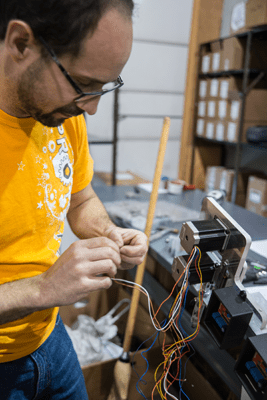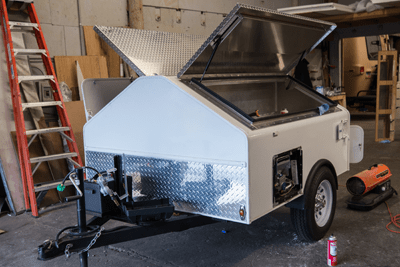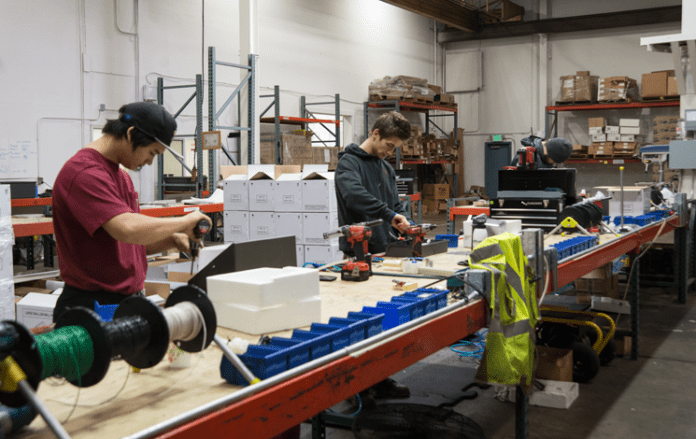You’ve been assigned a treasure hunt. You only have to find four items: a 155-gallon stainless steel tank, a roll of electrically conductive 3D printing filament, a commercial LED lighting fixture, and… oh yes, an all-aluminum camper for a short-bed truck.
You may be surprised to find out that all four items are manufactured right here in Clark County.
Marks Design & Metalworks Brewing seems to be the Pacific Northwest’s middle name, and this company has taken advantage of the beer industry’s growth. Melinda Marks, company vice president, said the firm focuses on designing and manufacturing quality products that last a long time and support energy efficiency.
“The market has responded positively,” said Marks. “We’ve grown from two employees to 75 in four years.”
The company’s main product is stainless steel brewing systems, which consist of “kettles” (heating), whirlpools (cooling) and vessels (fermenters and bright tanks). The smallest vessel they make is a 5-barrel tank (each barrel is about 31 gallons); the largest vessel they have ever made holds 750 barrels.
“No one has made a bigger tank,” Marks stated. “And we’re building more right now.”
According to Marks, there is only one other company in the United States that builds American Society of Mechanical Engineers (ASME)-certified tanks. Her company has captured 15 percent of the U.S. market, with more than 175 customers served out of a 46,000-square-foot facility on Minnehaha Street. She added that the company is a 100-percent U.S. manufacturer, with metal and components obtained from U.S. sources.
“Our products are made from the ground up here,” said Marks. “We feel really good about that.”
Even though the company has grown quickly since its founding four years ago, Marks said they have not had any trouble hiring enough people. Because welding pressurized tanks is a unique field, the company provides in-house training.
“There is no other company here like ours. We’re training men and women with skills they can take anywhere in their job career,” Marks said.
ProtoPlant Inc.
 Several large players, including HP, are developing printers that can fabricate three-dimensional objects, using plastic filament for “ink.” These fused filament fabrication (FFF) machines are like a CNC hot glue gun, squirting out plastic and building the part up layer by layer.
Several large players, including HP, are developing printers that can fabricate three-dimensional objects, using plastic filament for “ink.” These fused filament fabrication (FFF) machines are like a CNC hot glue gun, squirting out plastic and building the part up layer by layer.
Seeing a new opportunity, Dustin Cram, president (and mechanical engineer) for ProtoPlant, said his firm has changed its focus from machining and engineering consulting to producing exotic materials for consumer-grade FFF machines.
“We found that in the consumer market there is a lot of focus on esthetics,” said Cram.
About 18 months ago, the company used Kickstarter to launch their first filament – a carbon fiber-filled product that has a matte black finish with shiny flecks, and is more rigid than normal plastic. The company has just released three new materials. One is an electrically conductive filament that can be used by dual-material printers to create basic circuits that can then be integrated with touch screens, LEDs and so on.
Two other new products include a stainless steel-filled material that enables the consumer to polish the finished print and an iron-filled material that lets prints rust (if that’s what the look the consumer wants) and have magnets stick to them.
ProtoPlant had a booth at the 2015 Consumer Electronics Show, and is currently working with a Longview company to meet ProtoPlant’s packaging needs. With himself, one employee, and two contractors, the company’s current 1,200-square-foot facility on 18th and Andresen is sufficient, said Cram, but he is considering moving to a larger facility in the future, perhaps as soon as next year.
Global TTL Manufacturing
In 2012, Terry Grover approached Twice the Light Inc. (TTL), located in central Vancouver, about manufacturing and distributing a new line of LED commercial lighting products designed by Grover, who is now director of product development for TTL.
Grover’s new product line, EnviroLux LED Products, focuses on energy savings. Grover said that the LED market is regulated by the U.S. Department of Energy, and requires products to pass stringent tests, the results of which are posted on the DOE website.
“We are at the top of the list of LED overall efficiency in the United States,” said Grover.
They achieve that, he said, by managing the thermal heat of the fixture, which enables their products to be 40 percent more efficient than competitors’ products (meaning that an EnviroLux fixture can save 80 percent compared to a standard fixture’s energy usage).
You can see EnviroLux fixtures in use around Clark County, such as at the Port of Vancouver, the lighting on the Columbia River east of the I-5 bridge and in a horticultural operation in Battle Ground that uses 3,500 EnviroLux fixtures. If you’re traveling, keep an eye out too – the company was recently awarded a contract to replace the exterior lighting for LAX Airport in Los Angeles.
Another project Grover is excited about is a collaboration with Bosch Energy, which has invested $2.3 million in solar technology that can be used with LED lighting in large commercial applications as well as high rise office buildings.
“Our fixtures would allow their products to operate at full efficiency for a long time,” explained Grover. He expects the first project to be complete in late 2015.
Superior RV Manufacturing Inc.
 James Sweet and his brother Richard used to build custom homes – some as far away as Castle Rock. Now they build a different kind of custom home – Panther Campers. The company, which is also a full-service RV center and storage facility just south of 119th Street near St. John’s, began building campers in 2005.
James Sweet and his brother Richard used to build custom homes – some as far away as Castle Rock. Now they build a different kind of custom home – Panther Campers. The company, which is also a full-service RV center and storage facility just south of 119th Street near St. John’s, began building campers in 2005.
“Rich came across a small camper in western Idaho that would fit on small trucks. He envisioned us building them, and it just grew,” said Sweet, who is Superior’s sales manager.
He said they spent a lot of time developing their product, trying out different ideas. Over time, he said, the Panther Camper “came alive” – a sporty dynamic, lightweight camper with conventional amenities such as a sink, furnace, comfortable bed and seating. Originally, they used wood framing with an aluminum skin (instead of the industry-standard fiberglass). But now the campers have an aluminum frame as well as skin, which is not only light, but also stands up to the region’s wet weather better than wood.
Sweet said that keeping the campers small and lightweight can be tricky. The company is also committed to quality construction, such as using 3/4-inch plywood instead of 5/8-inch or particle board for interior woodwork. They make two models. The Cascade is small with a low profile, and fits all trucks – even compacts, short beds and long beds. The Sierra is a full cab-over, taller, with a queen sized bed.
Sweet said that with gas prices coming down and the economy recovering, interest in Panther Campers has been mounting. Most of their business he said, was through word of mouth references.




